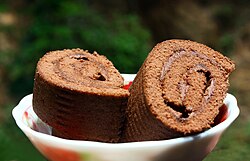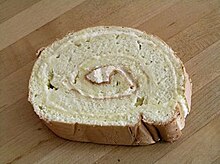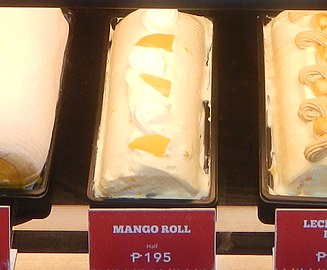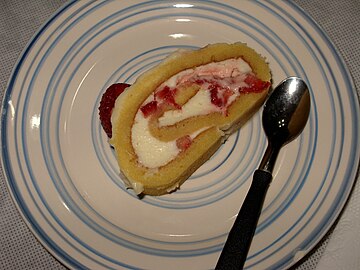| This article needs additional citations for verification. Please help improve this article by adding citations to reliable sources. Unsourced material may be challenged and removed. Find sources: "Swiss roll" – news · newspapers · books · scholar · JSTOR (February 2013) (Learn how and when to remove this message) |
 A Sri Lankan Swiss roll A Sri Lankan Swiss roll | |
| Alternative names | Jelly roll, roll cake, Swiss log |
|---|---|
| Type | Sponge cake |
| Place of origin | Place of origin currently unknown. |
| Main ingredients | Flour, eggs, sugar, jam or buttercream |
A Swiss roll, jelly roll (United States), roll cake, cream roll, roulade or Swiss log or swiss cake —is a type of rolled sponge cake filled with whipped cream, jam, icing, or any type of filling. The origins of the term are unclear; in spite of the name "Swiss roll", the cake is believed to have originated elsewhere in Central Europe, possibly Austria or Slovenia. It appears to have been invented in the nineteenth century, along with Battenberg cake, doughnuts, and Victoria sponge. In the U.S., commercial snack-sized versions of the cake are sold with the brand names Ho Hos, Yodels, Swiss Cake Rolls, and others. A type of roll cake called Yule log is traditionally served at Christmas.
The spiral layered shape of the Swiss roll has inspired usage as a descriptive term in other fields, such as the jelly roll fold, a protein fold, the "Swiss roll" metamaterial in optics, and the term jelly roll in science, quilting and other fields.
History

The earliest published reference for a rolled cake spread with jelly was in the Northern Farmer, a journal published in Utica, New York, in December 1852. Called "To Make Jelly Cake", the recipe describes a modern "jelly roll" and reads: "Bake quick and while hot spread with jelly. Roll carefully, and wrap it in a cloth. When cold cut in slices for the table."
The terminology evolved in America for many years. From 1852 to 1877 such a dessert was called: Jelly Cake (1852), Roll Jelly Cake (1860), Swiss Roll (1872), Jelly Roll (1873), and Rolled Jelly Cake (1876). The name "Jelly Roll" was eventually adopted.
Roll Sandwich or Swiss Pudding appears in the second edition of The complete biscuit and gingerbread baker's assistant in 1854.
The origin of the term "Swiss roll" is unknown. The earliest British reference to a baked item by that name appeared in the Birmingham Journal for Saturday 10 May 1856, page 8, in an advert for Thomas Richards of 71 New Street, Birmingham, where he had '... the patronage bestowed on him for the last fourteen years as the maker of the celebrated Pork Pies, Swiss Rolls, French Pies, German & Genoa Cakes, Grantham and other Ginger Bread for which he defies competition ...' The inference is that Swiss rolls may date to 1842 in England.
A rolled cake appeared on a bill of fare dated 18 June 0000, published in the 1872 book A Voyage from Southampton to Cape Town, in the Union Company’s Mail Steamer "Syria" (London). A recipe for "Swiss roll" also appeared in the US that same year in The American Home Cook Book, published in Detroit, Michigan, in 1872.
Several 1880s to 1890s cookbooks from London, England, used the name Swiss roll exclusively.
The American Pastry Cook, published in Chicago in 1894, presented a basic "Jelly Roll Mixture" then listed variants made from it that included a Swiss roll, Venice roll, Paris roll, chocolate roll, jelly roll cotelettes, and decorated jelly rolls.
National variations
France
The Bûche de Noël is a traditional Christmas cake of French origin. It is a rolled cake, usually chocolate cake, filled with chocolate whipped cream and decorated with icing sugar to resemble a snow-covered tree log. There are many variations of this cake, including some that are not cakes but are made of sorbet, ice cream, or elaborate creations, offering a multitude of flavor combinations.
Germany
In Germany, it is called Biskuitrolle, which means "sponge cake roll". It can also be named after its filling (e.g. Zitronenrolle – lemon roll, Erdbeerrolle – strawberry roll).

Hong Kong
This type of cake was probably introduced in the late 19th or early 20th century, when Hong Kong was an integral British territory, and it has been sold in Hong Kong well before the existence of Western-style Asian bakeries such as Maxim. Popular variations include
- Swiss roll (Chinese: 瑞士卷 or 瑞士卷蛋糕) with a whipped cream filling,
- Chocolate Swiss roll (Chinese: 朱古力瑞士卷), and
- Others such as strawberry, coffee or orange fillings.
Overseas Chinatowns
Most US Chinatown bakeries sell the basic Hong Kong Swiss roll version. It essentially looks and tastes identical to the one sold in Hong Kong. A popular type of Swiss roll in Chinese bakeries in the US is the tiger roll (Chinese: 虎皮蛋糕卷), which has a golden, striped outer appearance derived from its outermost layer (egg yolk). It has traditional white cream inside, and is similar in appearance to tiger bread.
India
In India, Swiss rolls are called "jam rolls". They are sold across regional bakeries along with cream rolls and other local delicacies.
Indonesia
In Indonesia, the Swiss roll cake is called bolu gulung. Most bakeries sell Swiss rolls daily, and they are filled with butter cream, cheese or fruit jam. It is also very common for Swiss rolls to be sold by the slice, but some shops sell by both slice and roll.
Italy

In Sicily around Caltanissetta (Italy), there is a cake made with chocolate sponge, ricotta, and marzipan called the rollò (from French roulé).
Japan
In Japan, Swiss rolls are called "roll cake". They are filled with whipped cream and sometimes with fruits like strawberries.
Latin America
In Colombia, a Swiss roll is called either pionono or brazo de reina ("queen's arm"), and it is filled with dulce de guayaba (guava jam) or arequipe. In Argentina, Uruguay and Peru, it is also called pionono, and it is filled with dulce de leche or manjar blanco (which are a more caramelized and thicker version of condensed milk). In Chile it is called brazo de reina, filled with dulce de leche only, and sprinkled with powdered sugar. It is called arrollado in Costa Rica.
In Puerto Rico and Venezuela it is known as brazo de gitano, but there is a vast array of fillings that include cream, chocolate truffle, dulce de guayaba, dulce de leche manjar blanco, often combined with fruits. In Brazil, it is called rocambole. In Mexico it is called niño envuelto ("wrapped child"). In Ecuador, Guatemala and Uruguay it is known as a brazo gitano ("gypsy's arm").
Southeast Asia
Varieties produced in Southeast Asia include kaya, pandan, blueberry, strawberry, sweet potato, taro, vanilla, orange, chocolate, raspberry, and even local fruits like durian, cempedak, and mango.
Philippines
Main articles: Mamón and Pionono § PhilippinesIn the Philippines, the most similar traditional pastry is the pionono which is part of the regular offerings of neighborhood bakeries since the Spanish colonial period. It is a rolled variant of the traditional Filipino sponge cakes (mamón) and similarly originally has a very simple filling of sugar and butter (or margarine). Modern versions, however, are commonly frosted and can include a variety of fillings. A very popular variant is the pianono version of the ube cake generally known as "ube rolls". It is flavored with ube (purple yam) and macapuno, giving it a characteristic vivid purple color. Mango pianono or "mango roll", a variant of the mango cake, are also popular and are made with ripe Carabao mangoes and cream. Another notable traditional pianono is the brazo de Mercedes ("arm of Our Lady of Mercy"), composed of a soft meringue body and a custard core. Due to American influence, pianonos are more commonly called "cake rolls" in modern times.
-
Filipino ube macapuno pionono
-
 Filipino mango rolls
Filipino mango rolls
-
 Filipino brazo de Mercedes, a meringue roll
Filipino brazo de Mercedes, a meringue roll
Portugal
In Portugal, desserts called tortas are commonly found on restaurant menus. Such desserts are not tarts, nor are they similar to German torte. They are simply Swiss rolls with jam filling.
Nordic countries
In Denmark, Norway, and Sweden the Swiss roll is called roulade, rullade, or rulltårta. An alternative Norwegian name is rullekake or, in some parts of the country, swissrull.
In Sweden and Finland, the Swiss roll is called rulltårta, respectively kääretorttu (both meaning "roll-cake"), and it is commonly served with coffee. The filling often consists of butter cream and strawberry jam. The base of a chocolate version, called drömrulltårta ("dream roll-cake"), is made mostly of potato flour, instead of the typical wheat flour, and it is filled with butter cream. More elaborate versions of the Swiss roll can be found in bakeries, with, for example, whipped cream and a crushed banana rolled in the middle, or with a thin marzipan coating that resembles a birch log.
Spain

In Spain, the dessert is called brazo de gitano (literally translated as "gypsy's arm") and is commonly filled with cream, jam (such as peach or apricot), powdered cocoa and nuts.
Switzerland
Despite its name, the Swiss roll appears not to have originated in Switzerland. Swiss rolls are called Biskuitroulade or Roulade in Swiss Standard German, gâteau roulé or roulade in French, rotolo or biscotto arrotolato in Italian and rullada in Rumantsch.
United Kingdom
In the UK, Swiss rolls are popular at teatime or as a dessert. A variety of Swiss rolls are sold in supermarkets in the United Kingdom, such as chocolate, lemon or jam (the last being the most popular). Jam Swiss rolls will be filled with jam and sometimes cream, with a sugar or chocolate-drizzled outer coating. Jam roly-poly is a similar dessert, but made as a suet pudding rather than a cake, filled with jam and served hot with custard.
"Caterpillar cakes" are Swiss rolls decorated to look like caterpillars, one popular commercial example being Marks and Spencer's Colin the Caterpillar.
United States

American pastry chefs and menus in fine dining restaurants often use the French term roulade. The chocolate Swiss roll, sometimes referred as "chocolate log", is a popular cake or dessert. Produced by many commercial bakeries, common brands include Ho Hos and Yodels, which are smaller-sized rolls for individual consumption. When the filling is ice cream, it is commonly referred to as an "ice cream cake roll", and although they can vary, these often consist of chocolate cake with vanilla ice cream.
See also
References
- "Swiss Roll". Cook's Info. Archived from the original on 1 June 2018. Retrieved 12 November 2015.
- "Potica". Jernej Kitchen. 17 April 2019. Retrieved 5 May 2022.
- "A History of Biscuits". Archived from the original on 23 February 2021. Retrieved 19 March 2015.
- George Read (1854). The complete biscuit and gingerbread baker's assistant. Dean and Son. p. 79.
- Gage, Mary. "Jelly Roll". Archived from the original on 9 February 2020. Retrieved 21 August 2013.
- Larousse Gastronomique. Octopus Publishing Group. 2001. ISBN 978-0-600-60688-8.
- Izzy Ozawa (11 May 2010). "Hong Kong's bakers du jour teach us how to roll a fat one". CNN. Archived from the original on 18 May 2012. Retrieved 14 August 2012.
- Caffè Caltanissetta. "Rollò di ricotta, del maestro Lillo De Fraia – Caffè Caltanissetta" (in Italian). "Zona Creativa" – via Palermo 42, 93100 Caltanissetta. Archived from the original on 13 May 2016. Retrieved 25 June 2015.
- Principe, Il (17 December 2016). "GLI ANGIOINI E GLI ARAGONESI". Un Principe in Cucina (in Italian). Archived from the original on 17 September 2024. Retrieved 28 December 2023.
- "ケーキピア(CakePia) 手作りケーキ・洋菓子・お菓子の簡単レシピ。". cakepia.info. Archived from the original on 17 September 2024. Retrieved 10 February 2014.
- "Puerto Rico Leisure Guide – 2021". Issuu. 4 June 2021. Archived from the original on 22 January 2022. Retrieved 22 January 2022.
- "Archives". The Star. Malaysia. Archived from the original on 14 July 2014. Retrieved 20 March 2014.
- "Pianono". Ang Sarap. 28 July 2017. Archived from the original on 22 April 2019. Retrieved 22 April 2019.
- "Pianono (Filipino Sponge Cake Roll)". Kawaling Pinoy. 23 April 2018. Archived from the original on 7 April 2019. Retrieved 22 April 2019.
- "Mango Swiss Roll". Atbp.ph. 12 March 2017. Archived from the original on 17 September 2024. Retrieved 15 May 2019.
- "How to Make Mango Cake Roll". Woman Scribbles. 30 September 2016. Archived from the original on 15 May 2019. Retrieved 15 May 2019.
- Brazo Gitano Archived 24 December 2014 at the Wayback Machine. goya.com

